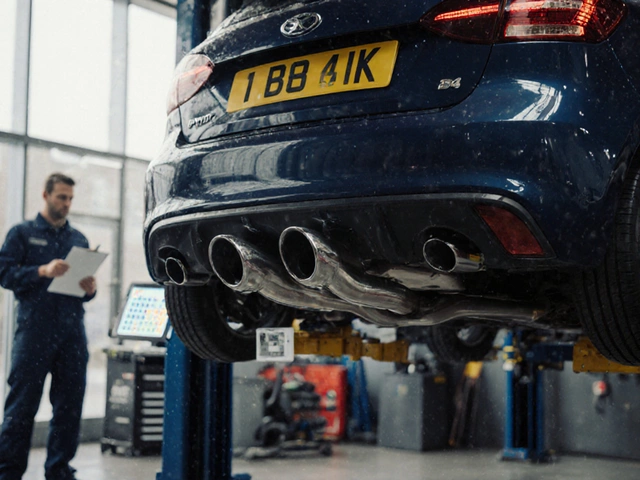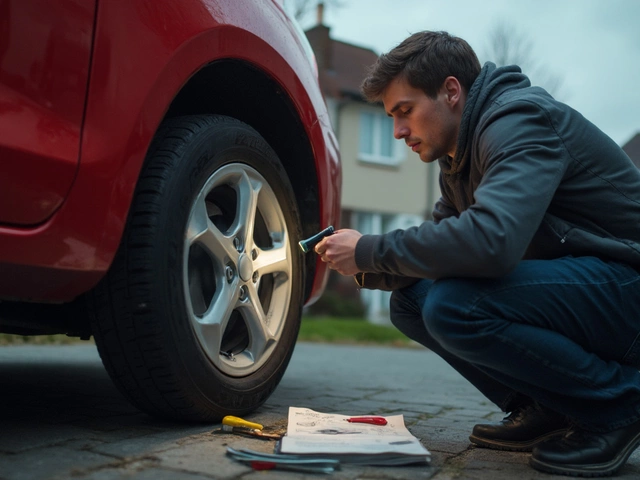Ever hop in your car on a hot day, crank up the AC, and all you feel is a weak, warm breeze? That’s a classic sign something’s off with your refrigerant—most people just call it Freon. When the Freon runs low, your AC doesn’t stand a chance against the heat, and no amount of blasting the dashboard settings will help.
The thing is, you don’t have to be a mechanic to catch when your AC is struggling because of low Freon. A few easy-to-spot clues can save you from suffering through sweaty drives. Knowing these signs early also helps you stop damage before it spreads to bigger, wallet-draining parts like your compressor or radiator. Curious how you can stay ahead of this? Let's walk through what to watch for.
- Why Freon Matters for Car AC
- Common Signs Your Freon Is Low
- What Causes Freon to Leak
- How to Check Freon at Home
- Fixing and Preventing Low Freon
Why Freon Matters for Car AC
Let’s get real: Freon is the heart of your car’s cooling system. Without enough of it, the air coming from your vents is just air—no cool relief. Freon isn't actually a brand, but a common nickname for the refrigerant running through your AC system. It moves in a loop, soaking up heat from inside the car and dumping it outside, leaving you with steady, cold air.
Here’s exactly what Freon does:
- It absorbs the heat inside your car through the evaporator coil.
- It carries that heat outside to the condenser, where the hot air gets blown away.
- The refrigerant then cycles back, ready to grab more heat and keep things cool.
Lose too much Freon, and the system can’t do its job. Your car feels stuffy, your windows fog up, and long trips start to feel like a workout in a sauna. It's not just about comfort, either. When your AC runs with low refrigerant, the compressor—the most expensive part—works overtime and can wear out fast. Repairs on compressors aren’t cheap; you’re looking at anywhere from $600 to $1,000 if it fails.
Here's a quick look at why keeping the right Freon level really matters for your car:
| Role of Freon | What Happens When Low |
|---|---|
| Keeps cabin air cool | AC blows warm or barely cool air |
| Protects AC compressor | Compressor overheats and can fail |
| Prevents system from freezing | Moisture freezes on lines, reducing airflow |
| Reduces humidity in car | Windows fog up more easily |
Bottom line: Don’t brush off low Freon signs. A quick check or recharge now means way fewer headaches (and bills) down the road.
Common Signs Your Freon Is Low
If your car’s air conditioning starts acting up, low Freon is often to blame. But before you shell out money on a full AC overhaul, it makes sense to check for clear signs first. Here are the main things you’ll notice if your car’s AC is crying out for refrigerant:
- AC Blows Warm Air: This is the big one. If your AC is running but only pushes air that's barely cooler than outside, your AC car probably needs more Freon. The colder the refrigerant, the colder your cabin. No refrigerant? Just lukewarm air.
- Compressor Doesn’t Engage: When you switch on the AC, you usually hear a faint "click". That’s the compressor kicking in. If you don’t hear it and you’re only getting normal fan noise, your system could be too low on refrigerant to trigger the compressor.
- Visible Leaks or Pooling: Refrigerant is a gas at room temperature but is mixed with some oil. Sometimes, you’ll spot tiny greasy spots around your AC fittings or hoses under the hood. These oily spots are a classic sign of a leak—and a Freon leak is usually why the level gets low in the first place.
- Hissing Sound from AC: When you shut the car off after running the AC, you might hear a soft hissing sound for a few seconds. This can mean low pressure, which might be caused by low Freon or a leak.
- Longer Cooling Time: If your car’s AC takes ages to cool off the cabin (assuming it ever does), that’s another sign the refrigerant’s running low.
According to the EPA, "Low refrigerant charge is the number one cause of air conditioning failure in vehicles today."
"Most air conditioner failures are related to refrigerant leaks. Noticing reduced cooling capacity early can save you from bigger repairs down the line." – Automotive Service Excellence (ASE)
| Sign | What It Means |
|---|---|
| Warm air from vents | Not enough refrigerant to cool the air |
| No compressor "click" | System pressure too low to engage |
| Oily residue | Possible refrigerant and oil leak |
| Hissing noise | Pressure equalizing, possibly low on refrigerant |
Being aware of these signs means you can act before you get stranded on a muggy afternoon with an AC that won’t work at all. Always remember: when it comes to your car radiator and AC, catching an issue sooner saves you cash later.

What Causes Freon to Leak
If your AC car isn’t cooling like it used to, chances are you’re dealing with a freon leak. And leaks are more common than you think—they don’t just happen out of the blue. There’s always a reason, and knowing the main troublemakers puts you a step ahead.
First off, the most typical cause is simple wear and tear. Over time, the rubber seals and hoses that hold the refrigerant break down. Heat, vibration from the engine, and age all work together to make rubber brittle. One tiny crack, and out goes your low refrigerant (freon).
Road debris isn’t your friend, either. Rocks and sand can hit your AC lines or the condenser (that’s up front, right near the car radiator), making small punctures. A leaking condenser or even a loose fitting around the connections can let freon sneak out.
- Worn out O-rings and seals: These parts keep everything sealed tight. When they harden or shrink, leaks aren’t far behind.
- Physical damage: Even a little bump at the front of your car can lead to a cracked condenser.
- Corrosion: Moisture gets inside, mixes with the refrigerant, and causes parts to rust. Corrosion eats away at metal, creating pinhole leaks.
- Poor maintenance: Skipping regular checks means small problems go unnoticed and turn into leaks.
As Mark Davis from Car Air Tech puts it,
"Most car AC leaks start small. If you catch them early, you can save the system and avoid expensive repairs. But most people only notice when the air turns warm."
Here’s a quick look at how common these issues are in everyday cars:
| Cause of Leak | Estimated Share (%) |
|---|---|
| Worn Seals & Hoses | 55% |
| Physical Damage | 20% |
| Corrosion | 15% |
| Others (like poor installation) | 10% |
So if your AC’s performance drops, don’t just crank it to max and hope for the best. It’s always a good idea to look for leaks and get them fixed before things get worse and drain your wallet even more.
How to Check Freon at Home
You don’t need a full toolbox to figure out if your AC car is low on freon. Most people just want to know if the problem really is with the refrigerant before heading to a pro. Thankfully, there are a few solid ways you can check at home—and none of them require being a car expert.
First off, if the air coming out isn’t cold like before, that’s a giveaway. But let’s get more hands-on. The quickest check is to pop your hood and look at the AC lines while the car is running with the AC on max. Are the lines sweating or even icy cold to the touch? That’s a good sign. If they feel about the same as the engine bay (warm) or there’s no moisture, you may be low on refrigerant.
The next method is using an AC pressure gauge. Kits are sold at most auto parts stores and are pretty cheap. They hook right up to the low-pressure port (usually has a blue or black cap labeled “L” for low). Here’s how to do it step by step:
- Turn your engine and air conditioning on full blast.
- Pop the hood and find the low-pressure port. (Check your owner’s manual if you can’t find it.)
- Attach the gauge according to the instructions on your kit.
- Read the pressure. If it’s under 25 psi, your freon is probably low.
If you want a quick cheat sheet, here’s what you should see depending on the outside temperature:
| Outside Temp (°F) | Normal AC Low Side Pressure (psi) |
|---|---|
| 65 | 25-35 |
| 75 | 30-40 |
| 85+ | 40-50 |
Final tip: Don’t try to add freon if you spot oily spots or obvious leaks around AC parts—fix those first, or you’ll just waste money. And if you aren’t sure, play it safe and get a pro to double-check. It beats roasting in your car on a summer day, trust me. Rufus whines when it’s too hot, so I know how brutal it can be!

Fixing and Preventing Low Freon
Once you know your freon level is low, you’ve got a couple of choices: you can try topping it up yourself, or you can let the pros handle it. It all depends on how comfortable you are popping the hood and dealing with a pressurized system. But here's the kicker: just refilling isn't a real fix if there’s a leak somewhere in your AC car system. Freon doesn’t just disappear, so if it’s low, it’s leaking.
If you’re set on fixing it yourself, you’ll need an AC recharge kit. These are easy to find at auto parts stores, and most kits have clear, step-by-step instructions. But don’t skip the leak check. Spraying soapy water around the AC hoses and connectors while the system is running can help you spot bubbles, which means there’s a leak.
- Put on gloves and safety glasses—freon can be dangerous.
- Attach the recharge kit to the low-pressure service port (usually marked with a bigger cap).
- Squeeze the trigger on the recharge can and watch the gauge to avoid overfilling.
- If you find a leak, don’t ignore it. Small ones can sometimes be patched with special sealers, but bigger leaks mean you should visit a pro who can safely repair or replace parts.
To prevent low refrigerant in the future, make it a habit to run your AC for at least 10 minutes every couple of weeks—even in winter. This keeps seals lubricated and helps spot problems early. Get a mechanic to check your AC system—especially the hoses and the car radiator area—every spring before the real heat kicks in.
- Park out of direct sun when you can. Extreme heat can stress your AC components and speed up hose failures.
- If your car is older than five years, have its AC checked at least once a year.
Fun fact: The Environmental Protection Agency says most cars lose about 10% of their freon each year, even with no real leaks. That slow loss is normal, but quick drops mean a repair is due.
| Fix | DIY or Mechanic | When to Choose |
|---|---|---|
| Top off freon | DIY | If you see no obvious leaks and want a quick cold boost |
| Seal small leaks | DIY or Mechanic | If you spot bubbles with soapy water test |
| Repair/replace parts | Mechanic | If a major leak is found, or if unsure where it is |
Don’t forget: running your AC with low freon can kill the compressor, and that’s the last thing your wallet needs. Catch issues early and those muggy summer drives will stay nice and cool.






